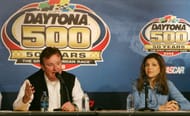NASCAR's Daytona 500 moved from the Daytona Beach Road Course to Daytona International Speedway in 1959. The shift was necessary due to increasing land usage, growing crowds, and the need for a permanent racing facility.
Bill France Sr., founder of NASCAR, realized in 1953 that racing on the beach was no longer sustainable. With a rapidly increasing population and rising attendance, a permanent track was needed. On April 4, 1953, France proposed the construction of a dedicated speedway in Daytona Beach, Florida.
On August 16, 1954, he signed a contract with officials from the City of Daytona Beach and Volusia County to build the track. Construction began in 1957, and the design included 31-degree highbanks to allow for higher speeds and better spectator visibility. Dirt from the infield was used to build the banking, which created a 29-acre lake known as Lake Lloyd.
In 1959, Daytona International Speedway officially replaced the beach-road course. The first-ever Daytona 500 was held on February 22, 1959, drawing over 41,000 spectators. The race featured a mix of hardtop and convertible cars, marking the only Daytona 500 to include convertibles.
The finish of the inaugural race was too close to call. Initially, Johnny Beauchamp was declared the winner, but after reviewing newsreel footage for 61 hours, NASCAR confirmed that Lee Petty had actually won by approximately two feet.
The track continued to change. In 1961, the Daytona 200 motorcycle race moved from the beach to the Speedway. The following year, Daytona hosted the first sports car endurance race, now known as the Rolex 24 At Daytona. The event initially lasted three hours but expanded to a 24-hour format in 1966.
In 2013, Daytona International Speedway underwent a $400 million renovation, known as the Daytona Rising project. Completed in 2016, the upgrades included wider seats, additional escalators, and more concession areas. Today, the facility hosts a variety of racing events, concerts, and social gatherings, making it one of the most versatile motorsports venues in the world.
One of NASCAR’s Greatest: The 1998 Daytona 500

The 1998 Daytona 500, held on February 15, was the 40th running of the event and marked a historic moment in NASCAR history. It was Dale Earnhardt’s first and only Daytona 500 victory after 19 unsuccessful attempts.
Earnhardt had already won races at Daytona International Speedway, including two summer races, 11 qualifying races, and multiple non-points events. However, victory in the 500 had always eluded him. His closest previous attempt came in 1990 when a last-lap flat tire cost him the win.
In the 1998 race, Earnhardt led 107 of the 200 laps, including the final 61. The race saw only three caution flags, making it one of the fastest Daytona 500s ever. As Earnhardt took the checkered flag, crew members from every team lined the pit road to congratulate him. Earnhardt’s victory was celebrated by fans and competitors alike. Richard Childress, his team owner, later said,
“He was the happiest that day that I’d ever seen him.” (via autoweek)
After reaching Victory Lane, he famously pulled a stuffed monkey from his shoulder and tossed it, marking the end of his long quest for a Daytona 500 win. After this race, Earnhardt had his final career victory in the 2000 Winston 500 on April 23, 2000.